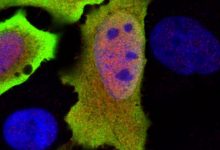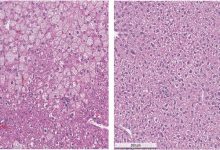
DNA is a long thread-like chain of nucleotides carrying the genetic instructions in the unique genetic code and mere change or even point mutations can lead to life-threatening diseases. These point mutations can transform single cell in the human body into a cancerous tumor or they can turn antibiotic-sensitive into antibiotic-resistant bacteria that cause untreatable infections. In an ideal world, clinicians would be able to remove cells with such deleterious point mutations right after they are created to fight diseases much more effectively.
In a new research led by Wyss Institute for Biologically Inspired Engineering suggests that the first step toward the goal has been achieved by converting the CRISPR/Cas9 genome engineering system into a genome surveillance tool. The CRISPR/Cas system is a prokaryotic immune system that confers resistance to foreign genetic elements such as those present within plasmids and phages that provides a form of acquired immunity.
The team has developed a method by which in-vivo mutation can be prevented coupled with enabling cleaving Cas9 enzyme to cut only unwanted nucleotide by discriminating between genomic target sites differing by a single nucleotide. The team performed the study in bacterial E. coli strains grown in culture or the mouse gastrointestinal tract and found that the approach can prevent the survival of antibiotic-resistant variants.
The function of Cas 9 enzyme is to act like a molecular pair of scissors and cutting the target sequence at a defined site and is guided to its target site by a small guide RNA with a complementary sequence.This deliberately introduced damage allows biologists to edit the genome of cells, but cell will die if left unrepaired. Despite system’s effectiveness in finding and cutting target sequences in the genome of many organisms, unspecific activity of Cas9 to randomly cut at secondary, not completely identical sites still pose a problem to genome engineers. Hence a target sequence carrying an undesired point mutation often cannot be sufficiently discriminated by Cas9 from its normal counterpart and selectively removed. Even designer Cas9 enzymes engineered to be more specific are thus far not able to completely solve this problem.
“By focusing instead on guide RNA features, our approach dramatically enhances Cas9’s specificity up to a level where single nucleotide polymorphisms can be clearly distinguished and unwanted genetic variants erased,” said George Church, Ph.D., who also is Professor of Genetics at Harvard Medical School (HMS) and of Health Sciences and Technology at Harvard and the Massachusetts Institute of Technology (MIT). “Our method opens up an entirely new way to think about disease prevention in the future.”
During the previous studies the researchers found that surprisingly, certain mismatches between a guide RNA and its target sequence don’t affect Cas9’s ability to cleave a specific site in the DNA. They assumed that for a given pair of targets that differ by a single point mutation, a set of mismatches could be identified in the guide RNA that would eliminate Cas9’s activity on the normal sequence while maintaining robust activity on the one with a deleterious point mutation. This would stop a cell with a mutation cold in its tracks right after it is born.
To develop their approach, the team leveraged known point mutations that occur in bacterial enzymes, providing pathogens with resistance to antibiotics. By focusing on several of these mutations and screening through guide RNA variants with different mismatch combinations, they were able to identify specific guide RNAs that stimulated Cas9 activity towards the mutated gene sequences but left the normal counterpart untouched.
According to the co-first author Benjamin Pruitt, a former Staff Research Scientist at the Wyss Institute, the mutation prevention system upheld antibiotic sensitivity in E. coli strains cultured in standard laboratory conditions as well in bacteria that were used to colonize the gastrointestinal tract of gnotobiotic mice. These multi-day mouse experiments involved sustained antibiotic dosing and demonstrated that the system is robust even when subjected to potentially significant environmental pressures
Although this mutation prevention system shows potential for future disease prevention, the researchers think their new finding can be used immediately to help the biotech industry so that large-scale cultures can be protected from mutations that reduce their productivity and make them prone to contaminations and to study microbial evolution.
“This strategy gives us the opportunity to study evolutionary mechanisms in microorganisms. For example, we are now able to prevent often occurring mutations that confer antibiotic resistance and ask, which other genetic changes could lead to the same result. This may improve our understanding of resistance mechanisms and potentially offer new therapeutic entry points,” said James Collins, Ph.D., who is also the Termeer Professor of Medical Engineering & Science at Massachusetts Institute of Technology (MIT) and a Professor of Biological Engineering at MIT.
In the light of this study, the researchers have arrived at the conclusion that this effort can lead to entirely new innovation in the CRISPR/Cas9 field, one that could lead to entirely new ways to prevent and treat a broad range of diseases.






